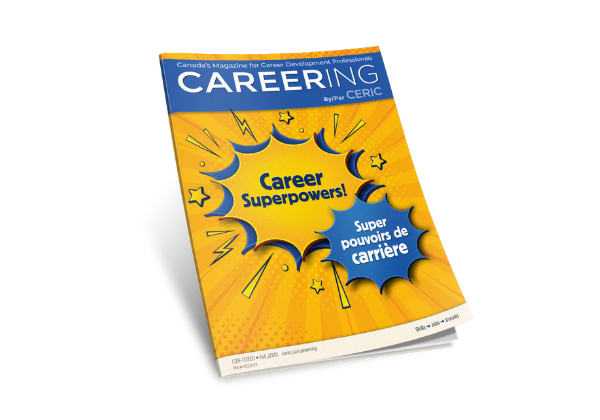
Supporting the careers of individuals who are Black, Indigenous and people of colour
October 6, 2020
Fall issue of Careering highlights Career Superpowers
October 7, 2020Being able to deliver a compelling career story will help jobseekers identify their value and communicate it to employers
Alastair MacFadden

In the face of uncertainty, many will seek refuge by just getting by; focusing on the short-term horizon and making choices that can undermine their preferred future.
Short-term thinking comes naturally in times of stress. A job applicant might relay the chronology of their resume rather than reveal their ambition or true self. A university student might choose more education over a leap into the job market. The impulse is to survive the immediate threat. It is an instinct that comes at a cost. By avoiding risk, we also foreclose on opportunities.
How can a person shape a career plan in the face of uncertainty? How do you excite strangers about your fit for a new opportunity? How can you become the hero of your own story?
These questions are fundamental for anyone engaged in a career journey. To help a client find their way, an essential superpower involves helping them master their story.
Why storytelling matters
We’ve all overcome difficulties, stumbled and learned. This personal narrative includes the stories we tell ourselves and others. In that sense, they define who we are. (Other leaders in career development have also described the importance of a personal narrative. Lysa Appleton (2018) offers another angle on storytelling in career development based, in part, on Joseph Campbell’s Hero’s Journey. )
More on storytelling from CareerWise:
To improve job interview performance, try a storytelling approach
Learning how to trust our clients’ stories
Here’s why storytelling is so powerful in career management:
Our minds are built to share and remember stories. Our physiology drives us to link fragments of information in patterns (Gottschall, 2012). When something is unclear, it is automatic to jump to conclusions, fill in gaps with assumptions and make up stories (or even conspiracies).
Arranging the story arranges the mind. Research has proven that knowing and applying your strengths leads to better engagement, productivity and well-being (Seligman, 2002). Stories integrate emotions, sensations and events into meaning. You can find confidence by exploring patterns and themes that reveal talents and resilience (Dingfelder, 2011).
A personal narrative positions you as the protagonist. When you’re the agent and not the victim of your story, you gain a sense of control and hope for what is still to come (Ibarra and Lineback, 2005). A story forms the context needed for self-compassion. The work of narrative psychology shows that those who find positive meaning in life events express greater life satisfaction.
Storytelling is a way to make sense of our lives. As you arrange the plot points, you highlight what has taken place and frame what is next in your career journey. Turning points gain significance through recall and interpretation, and maturity surfaces as we relate our past to our present and foreshadow possible futures. Your story gives you the words to close one career chapter and begin another.
We communicate and connect through stories. By mastering and then sharing your story, you form relationships with strangers. You can become someone memorable because sharing a multidimensional story creates an associative map across multiple brain regions (Lazarus and Snow, 2018).
There’s value in being able to tell a good story. Good stories transport the audience toward connection. Character-driven stories activate the production of oxytocin in the brain – a hormone associated with feelings of empathy, generosity, trust and co-operation (Zak, 2014). If you want help from others, your story helps them feel they have a stake in your success.
Building a coherent and compelling career story
A random, accidental and incoherent story is a drag. Compelling stories have structure that grabs attention and transports the audience into another world.
A coherent career story also has flow. It identifies plot points and draws connections between them. To help your client explore their story, ask them what has been significant or inspiring in their work life. Try using these questions as a prompt:
- As you look back, what are key turning points or events? What are personal experiences that best reflect your strengths, passions and achievement? Describe a time or two when you’ve been happiest in your work – what skills were you using in those moments?
- What has been the role of other people in your journey? Who are the mentors, coaches and allies who have influenced you? What advice have you received? What was the impact?
Next, work with your client to create headlines that capture these critical moments and relationships as the chapters in their career story. Encourage them to craft a vivid, concise description of experiences that are most relevant to the impression they want to leave others about their character and story.

Storytelling can serve as a powerful tool to connect with others. (iStock)
Delivering a story that connects
When someone asks your client, “What do you do?” or “Tell me about yourself” they are inviting a short story. Converting career chapters into human connection involves linking past experiences with the present and future.
To arrange the chapters and deliver a story that connects, good stories offer a consistent formula:
- Know your audience. The aim is to share a career story that will resonate with the audience. The client should tailor their narrative to the opportunities they are exploring. Scanning a job ad for keywords, for example, can point to elements of the story that should be emphasized in a cover letter or interview.
- Start by sharing something that may be surprising, such as a time you embarked on a personal challenge or crossed a career threshold.
- To sustain attention, build tension by sharing obstacles that have shaped you, such as a crisis or failure or an unusual project. Describe the insights gained, before leading to …
- The present state – a career crossroads – where you are taking a further step toward your preferred future.
Over time, each interview and tailored job application will bring the client clarity and a deeper sense of direction as they master their career story.
Anticipating the next chapter
Heroes don’t just endure difficulty and accept their fate. They exercise their strengths to prepare for the future. If a client feels they are preparing for an uncertain future, help them build their story with scenario planning. Have them focus on what is known:
- Their main talents, gifts and competencies. For example, what patterns are evident in the interests, experiences and life lessons in their career story?
- Trends shaping the future of their work life. What will be the impact on the client of personal and labour market trends over the next 10 or 20 years? Can they envision multiple futures or scenarios? (E.g. technological change or other trends in their profession, changes within their family or their family status, wider economic or social trends such as access to childcare or eldercare.)
- Choices in a changing world. How can the client’s talents be deployed in each of the future scenarios they envision? What partnerships or allies will matter? How can their knowledge, skills and attributes best be deployed? Of the tactics that fit each future scenario, which ones appear again and again? Those are the tactics that offer the most robust next steps for any plausible career future, and they should inform the client’s choices and their next chapter.
It is worth reminding the client that they are protagonist of their story. By helping them master storytelling, you are helping them gain a superpower that will build their confidence, form relationships and propel their career forward.
Alastair MacFadden is an Executive in Residence at the Johnson-Shoyama Graduate School of Public Policy. He has worked in the non-profit sector and government to advance career development practices and to help individuals reach their full potential.
References
Appleton, L. (2018). Storytelling a powerful tool in clients’ career development. CareerWise. careerwise.ceric.ca/2018/11/25/storytelling-a-powerful-tool-in-clients-career-development/
Dingfelder, S. (2011). Our Stories, Ourselves. American Psychological Association. Monitor on Psychology, 41(1). apa.org/monitor/2011/01/stories
Gottschall, J. (2012). The Storytelling Animal: How Stories Make Us Human. Houghton Mifflin Harcourt.
Ibarra, H. and K. Lineback. (2005). What’s Your Story? Harvard Business Review. hbr.org/2005/01/whats-your-story
Lazarus, J. and S. Snow. (2018). The Storytelling Edge: How to Transform Your Business, Stop Screaming Into the Void, and Make People Love You. Wiley.
Seligman, M.E.P. (2002). Authentic Happiness: Using the New Positive Psychology to Realize Your Potential for Lasting Fulfillment. Simon and Shuster
Zak, P.J. (2014). Why Your Brain Loves Good Storytelling. Harvard Business Review. hbr.org/2014/10/why-your-brain-loves-good-storytelling

